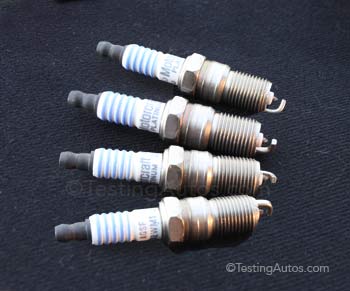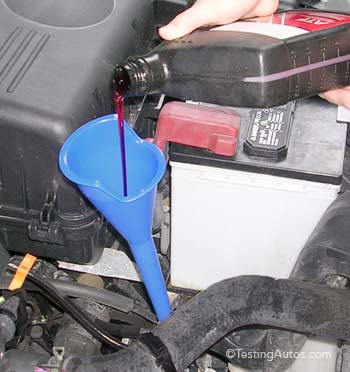When struts and shock absorbers should be replaced
Updated: December 07, 2022
Struts and shock absorbers in a vehicle should be replaced when they are leaking, damaged, bent or not working properly. Driving with a failed strut or shock absorber is not safe.It's also a good idea to replace struts or shock absorber as preventative maintenance, when they show signs of failing or excessive wear.
There are no mileage requirements for strut/shock replacement, however we often see struts and shock absorbers going bad after 110-120K miles in some cars. On the other hand, there are many cars in which strut or shock absorbers last for the lifetime of the vehicle.
Shock absorbers or 'shocks' and struts are parts of the vehicle's suspension. If when driving on a rough road, your car feels smooth and stable and doesn't bounce up and down, the shock absorbers/struts are doing their job. They absorb shocks of the suspension.
What is the difference between shock absorbers and struts? The strut or MacPherson strut is a shock absorber built into one unit with a coil spring and a strut mount.
All cars have four struts/shocks; one at each wheel. Most modern cars and SUVs have struts in the front suspension and shocks or struts in the back.
The most common problem with shocks and struts is when they start leaking. See the photos above. Struts and shock absorbers are filled with oil. If the unit starts leaking, it won't be long until it stops working. Sometimes a shock absorber or strut may stop working even without visible leaks.
What are the symptoms of a bad shock absorber or strut? Symptoms include bounciness and/or knocking when driving over bumps. The vehicle may feel less stable and smooth than before. You may notice that your car continues bouncing up and down after driving over a pothole.
To pinpoint a weak or failed strut or shock absorber, your mechanic may do a quick "bounce test" where each corner of the vehicle is pushed down and quickly released. The corner with the weak shock absorber or strut will keep bouncing up and down longer, while the corner with the good unit will rebound slowly and will not bounce more than twice.
Another common reason to replace struts is after hitting a major pothole, curb or after an accident. In any of these cases, the strut might be bent, which may not be visible, but can be detected during the wheel alignment. Driving with a failed strut or shock absorber is not safe. In addition, if one shock or strut is not working, there is more load on the other three, which will cause them to fail sooner.
Do you have to replace both shock absorbers or struts if only one is bad? It's not necessary, but it's usually recommended to replace them in pairs, for example, both front struts or both rear shocks. This is because a new shock absorber will absorb road bumps better than the old one. If you replace only one shock absorber, it may create "unevenness" from side to side when driving over bumps. However, if your car is not very old, replacing only one strut or shock absorber may be enough, since the opposite side is not worn out yet.
Should all four struts/shock absorbers be replaced at the same time? It's not necessary unless they are all bad, but it's one of the options. For example, if your truck has four old shock absorbers that are not very expensive and you want your truck to have a smoother ride, why not replace them all at the same time?
Do coil springs or strut mounts need to be changed when replacing the struts? The answer is no: if the springs or the struts mount are in good shape, they can be re-used with new struts. However, if a vehicle is old and strut mounts are known to fail in this vehicle, it makes sense to replace the strut mounts too. Read more: When do coil springs need replacing in a car? and Top strut mounts and upper shock mounts: when to replace?
Do sway bar links (stabilizer bar links) need to be replaced with the struts? No, but in some cars, sway bar links are connected to the struts, see the image above. The sway bar link must be removed in order to replace the strut. Often, the nut that holds the link seizes up, making it difficult to remove without damaging the link.
Advertisement
The cost to replace struts can run from $600 to $850 per pair. When struts are replaced, in most cases the wheel alignment must also be performed. The wheel alignment costs from $80 to $150. Replacing struts involves removing coil springs that are under high tension. For this reason, it's not something that can be easily done at home as a DIY project. It's best to trust this job to your mechanic, as most repair shops have a special spring compressor tool that can safely assemble or disassemble a loaded strut.
Replacing shock absorbers is cheaper: $280-$420 for both. In most cars, you don't need to do the wheel alignment when the shock absorber is replaced.
Read Next:
How often should the wheel alignment be done?
When do the control arms need to be replaced?
When does the tie rod end need to be replaced?
When do coil springs need replacing in a car?
Top strut mounts and upper shock mounts: when to replace?
When to replace sway bar links?
When do the ball joints need to be replaced?
When do leaf springs need to be replaced?
How To Save Money on Car Repairs - Mechanic's Tips
How often should the wheel alignment be done?
When do the control arms need to be replaced?
When does the tie rod end need to be replaced?
When do coil springs need replacing in a car?
Top strut mounts and upper shock mounts: when to replace?
When to replace sway bar links?
When do the ball joints need to be replaced?
When do leaf springs need to be replaced?
How To Save Money on Car Repairs - Mechanic's Tips











